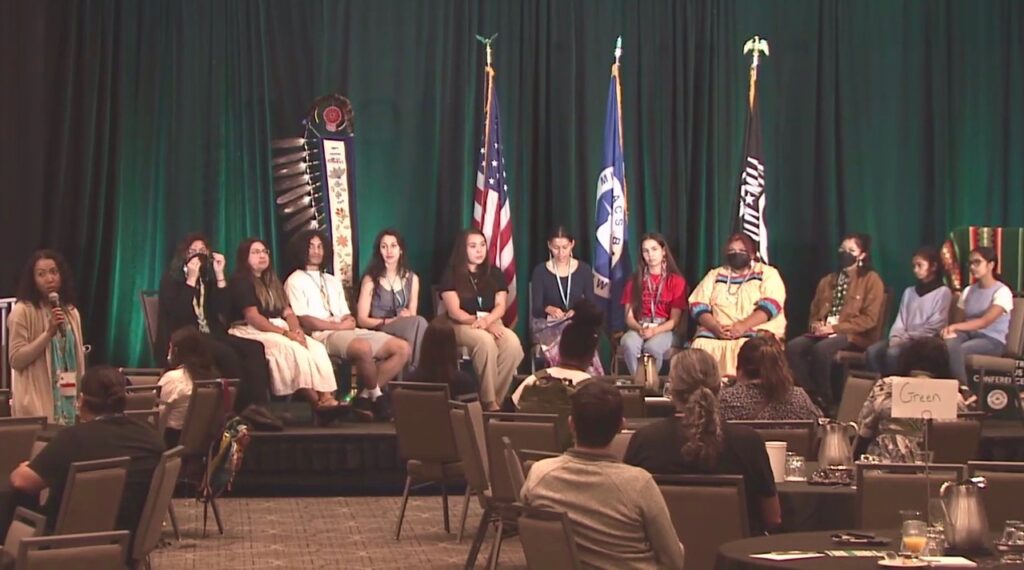Participants at the recently concluded National Tribal and Indigenous Climate Conference focused on the resilience of Native peoples and celebrated the work of young activists.
By Melanie Lenart

With optimism as an underlying theme, the first in-person National Tribal and Indigenous Climate Conference drew about 300 participants of all ages to St. Paul, Minnesota, in late August, with a comparable number participating online.
With an official theme of “Today’s stewards, tomorrow’s ancestors,” conference organizers and many of the speakers emphasized the importance of youth activists in the movement to protect the land, water and all forms of life from the ravages of climate change.
“I read that for young people, this is their number one concern, their number one worry. And they’re not just a little worried—they’re scared,” Mac Isham Jr., representing the Great Lakes Indian Fish & Wildlife Commission, told participants during the opening plenary session on Aug. 30. “I confess I’m a little worried. I’m an optimist, but I’m worried about that seventh generation.”
After coming across a United Nation report that suggested the world’s Indigenous peoples are the most vulnerable to climate change, Isham said he went back to the elders in his Ojibwe community to get their opinions. The elders reminded him that their people had already survived, among other things, attempted genocide, chemical warfare with strychnine in the water, and boarding schools. They convinced him that Indigenous peoples are the most likely to survive, given their well-honed skills in adaptation.
“Their response gave me the optimism that I needed,” Isham said. “Fossil fuel divestment is happening in real time. And scientists are really, really coming through for us. So yes, in fact, there’s many reasons to be optimistic, facing this real threat of climate change. I’m optimistic that you all—not Superman, not Iron Man, not Wonder Woman—you all are the superheroes that are going to save our planet.”
Optimism has been in short supply after two years of a deadly pandemic. In fact, the first biannual conference, held in August of 2020, had to shift quickly to an online format as the country and the world shut down, said Ann Marie Chischilly during the opening plenary. But the shift did allow the participation of more people. So conference organizers from the Institute for Tribal Environmental Professionals decided to offer many of the sessions online even while carrying out the original plans to meet in Minneapolis.
Chischilly, who recently stepped down as the institute’s director to accept a position as vice president for the Office of Native American Initiatives at Northern Arizona University, welcomed participants from “all across Turtle Island, and the world,” including China, Canada, India, Nepal, Ecuador, Peru, Mexico, the United Kingdom and New Zealand.
She noted that today’s young Indigenous people represent the “seventh generation” that Black Elk referenced back in the 1800s, saying they would help restore the hoop of life.
“They will get us through, and they will get the rest of the world through,” she said. “They’re rising up throughout the entire world. You can see them. They’re no longer waiting for the adults to make good decisions. They’re saying, ‘Get out of the way. Get out of the way now.’ ”
Conference sessions generally provided additional reasons for hope, with discussions focused on what tribal nations were doing to protect their lands and waters in these challenging times. Sessions included ways to access funding from private and federal programs, existing or proposed databases that could support tribal efforts, how food sovereignty and forest management can help with adaptation, efforts to bridge traditional and Indigenous knowledge and western science, ecosystem recovery and climate services.
“We go to a major conference and we’re part of a track, but we’re not on the main menu, so to speak,” explained Nikki Cooley, a conference coordinator and new assistant director of ITEP. “We just wanted to brag about all the work that tribes are doing, Indigenous peoples all over the world, that are doing really amazing work leading the efforts in addressing climate change. And also have them come to a space that focused just on them.”
In the closing plenary, Nick Tilsen, president and CEO of the NDN Collective, a conference co-sponsor, urged participants to welcome positive change.
“We can look at this as the ship is sinking, and that humanity doesn’t have a chance,” he said, admitting that some days it feels like that. But he wondered aloud if Indigenous peoples romanticize their past as much as white people do, including by being hesitant to add new ceremonies to adapt to the new times.
“Is it possible that the best days of Indigenous people are actually in front of us and not behind us?” Tilsen said. “Ask that question of yourself. If the answer is yes, it invokes action today. It requires ceremony tomorrow. It requires us to exceed our expectations to get our Nations there.”
• • •
Melanie Lenart is a regular contributor to Native Science Report.
Story published September 9, 2022
• • •
Enjoyed this story? Enter your email to receive notifications.
